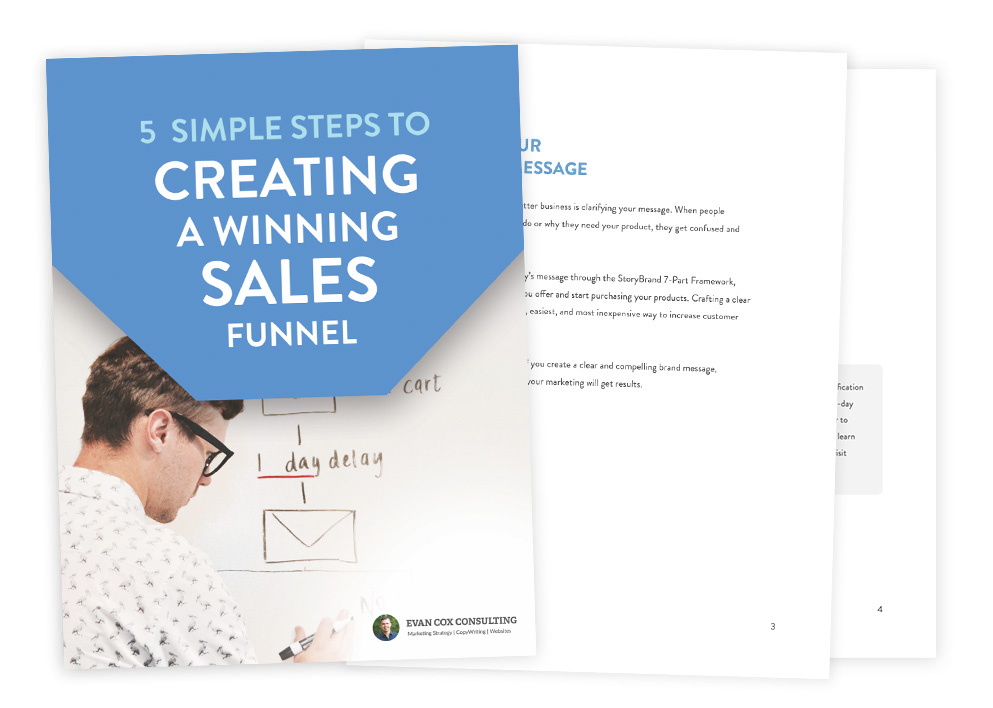StoryBrand is a powerful messaging framework developed by author and business leader Donald Miller. The premise is that you and your organization need to offer solutions to your customer’s problems. When you clearly articulate your products and services as the answer they’ve been searching for, your business or nonprofit grows in the process.
The 7 Parts of the StoryBrand framework
The Character
Every compelling story, novel, or major motion picture revolves around a central character. That person, or even group, is the dynamic hero on a journey. Whether it be a quest to transform or a goal to attain, the bottom line is every story’s character wants something.
The Problem
As you progress through a story, the plotlines offering narrative traction introduce a problem. A challenge or obstacle arrives, agitating a pain point for our character, the hero of the story. It’s essential to keep in mind that there is rarely just one problem.
There’s an external problem. This is something the character tangibly doesn’t have—expertise, tools, skills, time, money, etc.
There’s an internal problem. This problem tugs at their emotions—fear, doubt, guilt, frustration, anger, etc.
There’s a philosophical problem too. This represents the good versus evil we find embedded in the story’s primary theme. The guy deserves to get the girl. A villain shouldn’t bully the community.
Quite simply, without a formidable problem, the story doesn’t matter.
The Guide
At this juncture in the film, a wise sage typically enters the picture. They’ve been there before. They’ve battled the dragon. They now have answers that can serve the main character of the story well.
Some of our more famous Hollywood guide symbols include Yoda (from Star Wars), Obi Won Kenobi (also Star Wars), and Haymitch (The Hunger Games).
Keep in mind that a balanced guide displays empathy and authority.
Empathy reminds the hero that they understand their pain. They get it. Authority reassures the hero that they have the chops to serve them well.
The Plan
Any plot that has too many acts or controlling ideas will lose the audience. Instead, there needs to be a clear and trackable plan. A plan reassures the character and audience alike that we’re following a proven path to an end result. And human psychology studies confirm that the greater the detail, the harder it is to remember. For this reason, the best stories connect the dots between 3-4 steps of the overall plan.
Calls Them to Action
Giving the character a plan is good, but it’s just the start. That plan needs to call them to action. Consider Luke Skywalker in the original Star Wars trilogy. He was called to action to defeat the Death Star. It’s a climatic scene that induces a sense of transformation.
Yet, for many businesses a direct call to action (think “schedule a call” or “buy now” doesn’t accurately represent where the customer is at in the buyer’s journey.
For that reason, every good story needs a transitional call to action as well. Whether it be a valuable guide, quiz, assessment or even course, it’s important to create content to build trust.
Point the Character Toward Success
The point of any story is to end up with the desired result. Success. The dragon needs to be slain (The Hobbit). The ring needs to be destroyed (Lord of the Rings). The Empire needs to be defeated (Star Wars). You get the picture…
When correlating to your company, it’s equally important to remember that any customer or client is paying for an outcome—not your product or service. They want success.
Help Them Avoid Failure
While success is valuable, highlighting what’s at stake is equally important. Katniss likely wouldn’t have volunteered as tribute in The Hunger Games if her family and community we’re at risk. Understanding what could happen due to inaction is a powerful motivator.
These seven steps outline the elements of the StoryBrand framework. Remember, they are the hero because the central figure in a story undergoes significant change. They’re dynamic – which means they’re the weakest character in the story. The guide, that’s you, is consistent, reliable, and trustworthy. This is a position of strength and ultimately posits you in a place to serve them well.
How to Build a StoryBrand for Your Business or Nonprofit
Here is where the rubber meets the road. Building a StoryBrand is all about creating a clear message that resonates with your target audience. In the words of Donald Miller, “when you confuse, you lose.”
Step #1: Create a BrandScript
Whether you scribble it down on a piece of paper, jot it down in Evernote, or even use this free tool, the first step to building a StoryBrand is to create a BrandScript. Outline your story by filling out descriptions for each of the 7 parts of the framework covered above. This will be the building block you need to create a whole host of other marketing materials.
Step #2: Write your organization’s story (aka Brand Narrative)
This step is optional, but extremely helpful. Take time to review your BrandScript and create a story that introduces the character (your customer), highlights their problems, connects them with a guide (you), and then brings them to success through a plan that calls them to action.
Step #3: Infuse your BrandScript into all your marketing efforts
Start by auditing your existing marketing materials for alignment.
- Are you talking about you or them?
- Are you clearly articulating a problem you solve?
- Are you calling your readers to action?
- Is future success evident?
If your audit leaves you feeling a bit down, don’t fret. This represents an opportunity. Make sure the message coming from your BrandScript translates to your website, sales funnel, digital channels, and print materials.
A Word of Caution—Watch Out for the Curse of Knowledge
The problem is tackling the task of creating a clear message is hard when you are also the expert. When you know everything about your business, it often comes with something Lee Lefever refers to as the curse of knowledge.
It’s the equivalent of trying to read the label from inside the bottle
The antidote? Step (temporarily) back into the hero seat and let someone else serve as the guide to clear up your brand’s message.
This could be a colleague, trusted friend, or you could even hire a StoryBrand Certified Guide like me to help. It’s important to evaluate which sounding board will be the right fit for you.
You can explore how we walk our clients through this process in greater detail during your free consultation.
The result? A crystal clear brand message that resonates with your ideal customer (like, the customer you wish you could clone a hundred times over) and leads to more revenue, profit, and growth for your company.
A Few Resources to Help You Build Your StoryBrand
- Read Building a StoryBrand by Donald Miller
- Watch the online course
- Listen to this podcast that walks you through the process
- Use this free tool to create your own BrandScript
- Nonprofits: we cover the nuances of nonprofit BrandScripts on this podcast interview
- Churches: we created this free resource just for you.


